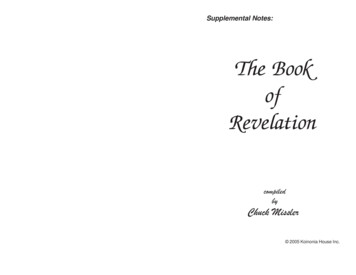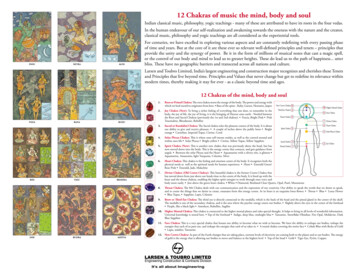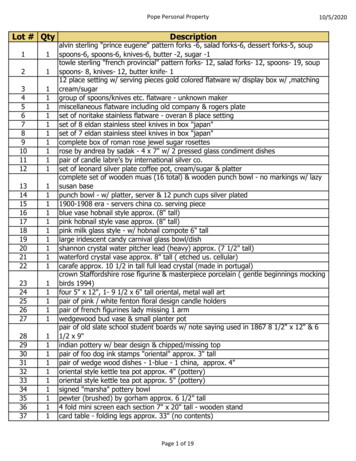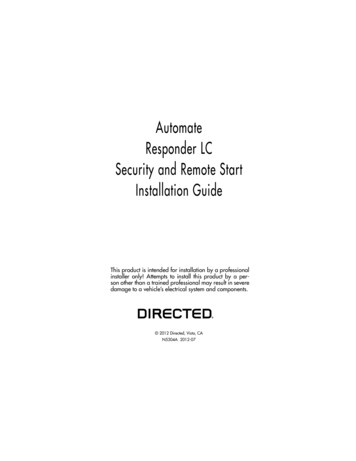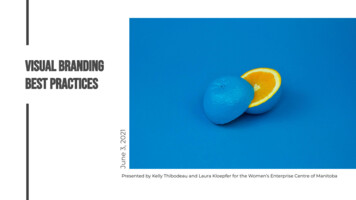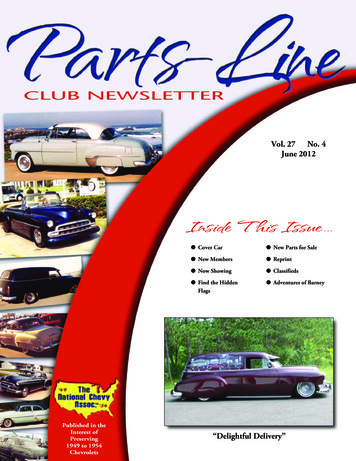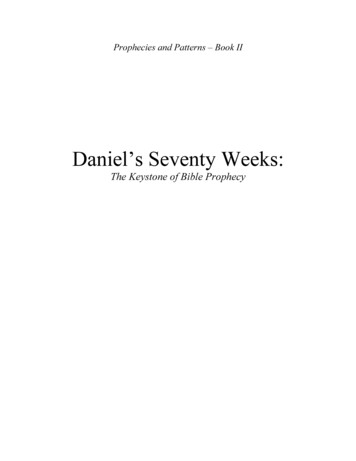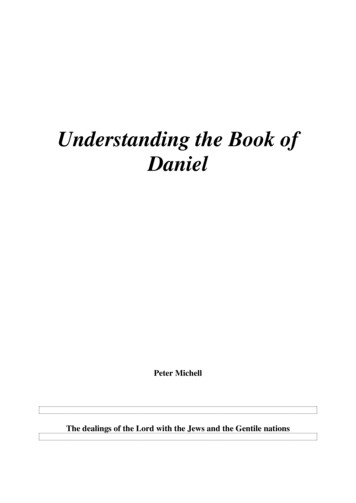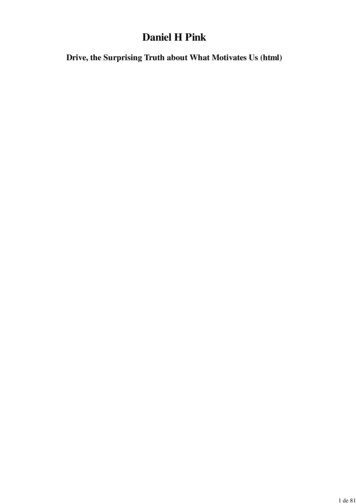
Transcription
Daniel H PinkDrive, the Surprising Truth about What Motivates Us (html)1 de 81
Table of ContentsTitle PageCopyright PageDedicationIntroduction2 de 81
Part One - A New Operating SystemCHAPTER 1 - The Rise and Fall of Motivation 2.0CHAPTER 2 - Seven Reasons Carrots and Sticks (Often) Don’t Work . . .CHAPTER 2A - . . . and the Special Circumstances When They DoCHAPTER 3 - Type I and Type XPart Two - The Three ElementsCHAPTER 4 - AutonomyCHAPTER 5 - MasteryCHAPTER 6 - PurposePart Three - The Type I ToolkitType I for Individuals: Nine Strategies for Awakening Your MotivationType I for Organizations: Nine Ways to Improve Your Company, Office, or GroupThe Zen of Compensation: Paying People the Type I WayType I for Parents and Educators: Nine Ideas for Helping Our KidsThe Type I Reading List: Fifteen Essential BooksListen to the Gurus: Six Business Thinkers Who Get ItThe Type I Fitness Plan: Four Tips for Getting (and Staying) Motivated to ExerciseDrive: The RecapDrive: The GlossaryThe Drive Discussion Guide: Twenty Conversation Starters to Keep You Thinking .FIND OUT MORE—ABOUT YOURSELF AND THIS TOPICAcknowledgementsNOTESINDEXALSO BY DANIEL H . PINKFree Agent NationA Whole New MindThe Adventures of Johnny Bunko3 de 81
4 de 81
RIVERHEAD BOOKSPublished by the Penguin GroupPenguin Group (USA) Inc., 375 Hudson Street, New York, New York 10014, USAPenguin Group (Canada), 90 Eglinton Avenue East, Suite 700, Toronto, OntarioM4P 2Y3, Canada (a division of Pearson Penguin Canada Inc.) Penguin Books Ltd,80 Strand, London WC2R 0RL, England Penguin Ireland, 25 St Stephen’s Green,Dublin 2, Ireland (a division of Penguin Books Ltd) Penguin Group (Australia),250 Camberwell Road, Camberwell, Victoria 3124, Australia (a division of PearsonAustralia Group Pty Ltd) Penguin Books India Pvt Ltd, 11 Community Centre,Panchsheel Park, New Delhi-110 017, India Penguin Group (NZ), 67 ApolloDrive, Rosedale, North Shore 0632, New Zealand (a division of PearsonNew Zealand Ltd) Penguin Books (South Africa) (Pty) Ltd, 24 SturdeeAvenue, Rosebank, Johannesburg 2196, South AfricaPenguin Books Ltd, Registered Offices: 80 Strand, London WC2R 0RL, EnglandCopyright 2009 by Daniel H. PinkAll rights reserved. No part of this book may be reproduced, scanned, or distributed inany printed or electronic form without permission. Please do not participate in orencourage piracy of copyrighted materials in violation of the author’s rights. Purchaseonly authorized editions. Published simultaneously in CanadaThe author gratefully acknowledges permission to reprint the following:Excerpt of “Sext” from Horae Canonicae copyright 1955 by W. H. Auden.Unless otherwise indicated, all illustrations in this book are by Rob Ten Pas.Library of Congress Cataloging-in-Publication DataPink, Daniel H.Drive : the surprising truth about what motivates us / Daniel H. Pink.p. cm.Includes bibliographical references and index.eISBN : 978-1-101-15214-01. Motivation (Psychology). I. Title.BF503.P153.1’534—dc22While the author has made every effort to provide accurate telephone numbers and Internet addresses at the time of publication, neither the publisher nor the authorassumes any responsibility for errors, or for changes that occur after publication. Further, the publisher does not have any control over and does not assume anyresponsibility for author or third-party websites or their content.http://us.penguingroup.comFor Sophia, Eliza, and Saul—the surprising trio that motivates meINTRODUCTIONThe Puzzling Puzzles of Harry Harlow and Edward DeciIn the middle of the last century, two young scientists conducted experiments that should have changed the world—but did not.Harry F. Harlow was a professor of psychology at the University of Wisconsin who, in the 1940s, established one of theworld’s first laboratories for studying primate behavior. One day in 1949, Harlow and two colleagues gathered eight rhesusmonkeys for a two-week experiment on learning. The researchers devised a simple mechanical puzzle like the one pictured onthe next page. Solving it required three steps: pull out the vertical pin, undo the hook, and lift the hinged cover. Pretty easy foryou and me, far more challenging for a thirteen-pound lab monkey.5 de 81
Harlow’s puzzle in the starting (left) and solved (right) positions.The experimenters placed the puzzles in the monkeys’ cages to observe how they reacted—and to prepare them for tests oftheir problem-solving prowess at the end of the two weeks. But almost immediately, something strange happened. Unbiddenby any outside urging and unprompted by the experimenters, the monkeys began playing with the puzzles with focus,determination, and what looked like enjoyment. And in short order, they began figuring out how the contraptions worked. Bythe time Harlow tested the monkeys on days 13 and 14 of the experiment, the primates had become quite adept. They solvedthe puzzles frequently and quickly; two-thirds of the time they cracked the code in less than sixty seconds.Now, this was a bit odd. Nobody had taught the monkeys how to remove the pin, slide the hook, and open the cover. Nobodyhad rewarded them with food, affection, or even quiet applause when they succeeded. And that ran counter to the acceptednotions of how primates—including the bigger-brained, less hairy primates known as human beings—behaved.Scientists then knew that two main drives powered behavior. The first was the biological drive. Humans and other animalsate to sate their hunger, drank to quench their thirst, and copulated to satisfy their carnal urges. But that wasn’t happening here.“Solution did not lead to food, water, or sex gratification,” Harlow reported.1But the only other known drive also failed to explain the monkeys’ peculiar behavior. If biological motivations came fromwithin, this second drive came from without—the rewards and punishments the environment delivered for behaving in certainways. This was certainly true for humans, who responded exquisitely to such external forces. If you promised to raise our pay,we’d work harder. If you held out the prospect of getting an A on the test, we’d study longer. If you threatened to dock us forshowing up late or for incorrectly completing a form, we’d arrive on time and tick every box. But that didn’t account for themonkeys’ actions either. As Harlow wrote, and you can almost hear him scratching his head, “The behavior obtained in thisinvestigation poses some interesting questions for motivation theory, since significant learning was attained and efficientperformance maintained without resort to special or extrinsic incentives.”What else could it be?To answer the question, Harlow offered a novel theory—what amounted to a third drive: “The performance of the task,” hesaid, “provided intrinsic reward.” The monkeys solved the puzzles simply because they found it gratifying to solve puzzles.They enjoyed it. The joy of the task was its own reward.If this notion was radical, what happened next only deepened the confusion and controversy. Perhaps this newly discovereddrive—Harlow eventually called it “intrinsic motivation”—was real. But surely it was subordinate to the other two drives. Ifthe monkeys were rewarded—with raisins!—for solving the puzzles, they’d no doubt perform even better. Yet when Harlowtested that approach, the monkeys actually made more errors and solved the puzzles less frequently. “Introduction of food inthe present experiment,” Harlow wrote, “served to disrupt performance, a phenomenon not reported in the literature.”Now, this was really odd. In scientific terms, it was akin to rolling a steel ball down an inclined plane to measure itsvelocity—only to watch the ball float into the air instead. It suggested that our understanding of the gravitational pulls on ourbehavior was inadequate—that what we thought were fixed laws had plenty of loopholes. Harlow emphasized the “strengthand persistence” of the monkeys’ drive to complete the puzzles. Then he noted:It would appear that this drive . . . may be as basic and strong as the [other] drives. Furthermore, there is some reasonto believe that [it] can be as efficient in facilitating learning.2At the time, however, the prevailing two drives held a tight grip on scientific thinking. So Harlow sounded the alarm. Heurged scientists to “close down large sections of our theoretical junkyard” and offer fresher, more accurate accounts of humanbehavior.3 He warned that our explanation of why we did what we did was incomplete. He said that to truly understand thehuman condition, we had to take account of this third drive.Then he pretty much dropped the whole idea.6 de 81
Rather than battle the establishment and begin offering a more complete view of motivation, Harlow abandoned thiscontentious line of research and later became famous for studies on the science of affection.4 His notion of this third drivebounced around the psychological literature, but it remained on the periphery—of behavioral science and of our understandingof ourselves. It would be two decades before another scientist picked up the thread that Harlow had so provocatively left onthat Wisconsin laboratory table.In the summer of 1969, Edward Deci was a Carnegie Mellon University psychology graduate student in search of adissertation topic. Deci, who had already earned an MBA from Wharton, was intrigued by motivation but suspected thatscholars and businesspeople had misunderstood it. So, tearing a page from the Harlow playbook, he set out to study the topicwith the help of a puzzle.Deci chose the Soma puzzle cube, a then popular Parker Brothers offering that, thanks to YouTube, retains something of acult following today. The puzzle, shown below, consists of seven plastic pieces—six comprising four one-inch cubes, onecomprising three one-inch cubes. Players can assemble the seven pieces into a few million possible combinations—fromabstract shapes to recognizable objects.The seven pieces of the Soma puzzle unassembled (left) and then fashioned into one of several million possibleconfigurations.For the study, Deci divided participants, male and female university students, into an experimental group (what I’ll callGroup A) and a control group (what I’ll call Group B). Each participated in three one-hour sessions held on consecutive days.Here’s how the sessions worked: Each participant entered a room and sat at a table on top of which were the seven Somapuzzle pieces, drawings of three puzzle configurations, and copies of Time, The New Yorker, and Playboy. (Hey, it was 1969.)Deci sat on the opposite end of the table to explain the instructions and to time performance with a stopwatch.In the first session, members of both groups had to assemble the Soma pieces to replicate the configurations before them. Inthe second session, they did the same thing with different drawings—only this time Deci told Group A that they’d be paid 1(the equivalent of nearly 6 today) for every configuration they successfully reproduced. Group B, meanwhile, got newdrawings but no pay. Finally, in the third session, both groups received new drawings and had to reproduce them for nocompensation, just as in session one. (See the table below.)HOW THE TWO GROUPS WERE TREATEDThe twist came midway through each session. After a participant had assembled the Soma puzzle pieces to match two of thethree drawings, Deci halted the proceedings. He said that he was going to give them a fourth drawing—but to choose the rightone, he needed to feed their completion times into a computer. And—this being the late 1960s, when room-straddlingmainframes were the norm and desktop PCs were still a decade away—that meant he had to leave for a little while.On the way out, he said, “I shall be gone only a few minutes, you may do whatever you like while I’m gone.” But Deciwasn’t really plugging numbers into an ancient teletype. Instead, he walked to an adjoining room connected to the experimentroom by a one-way window. Then, for exactly eight minutes, he watched what people did when left alone. Did they continuefiddling with the puzzle, perhaps attempting to reproduce the third drawing? Or did they do something else—page through themagazines, check out the centerfold, stare into space, catch a quick nap?In the first session, not surprisingly, there wasn’t much difference between what the Group A and Group B participants didduring that secretly watched eight-minute free-choice period. Both continued playing with the puzzle, on average, for between7 de 81
three and a half and four minutes, suggesting they found it at least somewhat interesting.On the second day, during which Group A participants were paid for each successful configuration and Group Bparticipants were not, the unpaid group behaved mostly as they had during the first free-choice period. But the paid groupsuddenly got really interested in Soma puzzles. On average, the people in Group A spent more than five minutes messing withthe puzzle, perhaps getting a head start on that third challenge or gearing up for the chance to earn some beer money when Decireturned. This makes intuitive sense, right? It’s consistent with what we believe about motivation: Reward me and I’ll workharder.Yet what happened on the third day confirmed Deci’s own suspicions about the peculiar workings of motivation—andgently called into question a guiding premise of modern life. This time, Deci told the participants in Group A that there wasonly enough money to pay them for one day and that this third session would therefore be unpaid. Then things unfolded just asbefore—two puzzles, followed by Deci’s interruption.During the ensuing eight-minute free-choice period, the subjects in the never-been-paid Group B actually played with thepuzzle for a little longer than they had in previous sessions. Maybe they were becoming ever more engaged; maybe it was justa statistical quirk. But the subjects in Group A, who previously had been paid, responded differently. They now spentsignificantly less time playing with the puzzle—not only about two minutes less than during their paid session, but about a fullminute less than in the first session when they initially encountered, and obviously enjoyed, the puzzles.In an echo of what Harlow discovered two decades earlier, Deci revealed that human motivation seemed to operate bylaws that ran counter to what most scientists and citizens believed. From the office to the playing field, we knew what gotpeople going. Rewards—especially cold, hard cash—intensified interest and enhanced performance. What Deci found, andthen confirmed in two additional studies he conducted shortly thereafter, was almost the opposite. “When money is used as anexternal reward for some activity, the subjects lose intrinsic interest for the activity,” he wrote.5 Rewards can deliver ashort-term boost—just as a jolt of caffeine can keep you cranking for a few more hours. But the effect wears off—and, worse,can reduce a person’s longer-term motivation to continue the project.Human beings, Deci said, have an “inherent tendency to seek out novelty and challenges, to extend and exercise theircapacities, to explore, and to learn.” But this third drive was more fragile than the other two; it needed the right environmentto survive. “One who is interested in developing and enhancing intrinsic motivation in children, employees, students, etc.,should not concentrate on external-control systems such as monetary rewards,” he wrote in a f ollow-up paper.6 Thus beganwhat for Deci became a lifelong quest to rethink why we do what we do—a pursuit that sometimes put him at odds withfellow psychologists, got him fired from a business school, and challenged the operating assumptions of organizationseverywhere.“It was controversial,” Deci told me one spring morning forty years after the Soma experiments. “Nobody was expectingrewards would have a negative effect.”THIS IS A BOOK about motivation. I will show that much of what we believe about the subject just isn’t so—and that theinsights that Harlow and Deci began uncovering a few decades ago come much closer to the truth. The problem is that mostbusinesses haven’t caught up to this new understanding of what motivates us. Too many organizations—not just companies, butgovernments and nonprofits as well—still operate from assumptions about human potential and individual performance thatare outdated, unexamined, and rooted more in folklore than in science. They continue to pursue practices such as short-termincentive plans and pay-for-performance schemes in the face of mounting evidence that such measures usually don’t work andoften do harm. Worse, these practices have infiltrated our schools, where we ply our future workforce with iPods, cash, andpizza coupons to “incentivize” them to learn. Something has gone wrong.The good news is that the solution stands before us—in the work of a band of behavioral scientists who have carried on thepioneering efforts of Harlow and Deci and whose quiet work over the last half-century offers us a more dynamic view ofhuman motivation. For too long, there’s been a mismatch between what science knows and what business does. The goal ofthis book is to repair that breach.Drive has three parts. Part One will look at the flaws in our reward-and-punishment system and propose a new way to thinkabout motivation. Chapter 1 will examine how the prevailing view of motivation is becoming incompatible with many aspectsof contemporary business and life. Chapter 2 will reveal the seven reasons why carrot-and-stick extrinsic motivators oftenproduce the opposite of what they set out to achieve. (Following that is a short addendum, Chapter 2a, that shows the specialcircumstances when carrots and sticks actually can be effective.) Chapter 3 will introduce what I call “Type I” behavior, away of thinking and an approach to business grounded in the real science of human motivation and powered by our thirddrive—our innate need to direct our own lives, to learn and create new things, and to do better by ourselves and our world.Part Two will examine the three elements of Type I behavior and show how individuals and organizations are using them toimprove performance and deepen satisfaction. Chapter 4 will explore autonomy, our desire to be self-directed. Chapter 5 willlook at mastery, our urge to get better and better at what we do. Chapter 6 will explore purpose, our yearning to be part ofsomething larger than ourselves.Part Three, the Type I Toolkit, is a comprehensive set of resources to help you create settings in which Type I behavior canflourish. Here you’ll find everything from dozens of exercises to awaken motivation in yourself and others, to discussionquestions for your book club, to a supershort summary of Drive that will help you fake your way through a cocktail party. Andwhile this book is mostly about business, in this section I’ll offer some thoughts about how to apply these concepts toeducation and to our lives outside of work.But before we get down to all that, let’s begin with a thought experiment, one that requires going back in time—to the dayswhen John Major was Britain’s prime minister, Barack Obama was a skinny young law professor, Internet connections weredial-up, and a blackberry was still just a fruit.8 de 81
Part OneA New Operating SystemCHAPTER 1The Rise and Fall of Motivation 2.0Imagine it’s 1995. You sit down with an economist—an accomplished business school professor with a Ph.D. in economics.You say to her: “I’ve got a crystal ball here that can peer fifteen years into the future. I’d like to test your forecasting powers.”She’s skeptical, but she decides to humor you.“I’m going to describe two new encyclopedias—one just out, the other to be launched in a few years. You have to predictwhich will be more successful in 2010.”“Bring it,” she says.“The first encyclopedia comes from Microsoft. As you know, Microsoft is already a large and profitable company. Andwith this year’s introduction of Windows 95, it’s about to become an era-defining colossus. Microsoft will fund thisencyclopedia. It will pay professional writers and editors to craft articles on thousands of topics. Well-compensated managerswill oversee the project to ensure it’s completed on budget and on time. Then Microsoft will sell the encyclopedia onCD-ROMs and later online.“The second encyclopedia won’t come from a company. It will be created by tens of thousands of people who write andedit articles for fun. These hobbyists won’t need any special qualifications to participate. And nobody will be paid a dollar ora euro or a yen to write or edit articles. Participants will have to contribute their labor—sometimes twenty and thirty hoursper week—for free. The encyclopedia itself, which will exist online, will also be free—no charge for anyone who wants touse it.“Now,” you say to the economist, “think forward fifteen years. According to my crystal ball, in 2010, one of theseencyclopedias will be the largest and most popular in the world and the other will be defunct. Which is which?”In 1995, I doubt you could have a found a single sober economist anywhere on planet Earth who would not have picked thatfirst model as the success. Any other conclusion would have been laughable—contrary to nearly every business principle shetaught her students. It would have been like asking a zoologist who would win a 200-meter footrace between a cheetah andyour brother-in-law. Not even close.Sure, that ragtag band of volunteers might produce something. But there was no way its product could compete with anoffering from a powerful profit-driven company. The incentives were all wrong. Microsoft stood to gain from the success ofits product; everyone involved in the other project knew from the outset that success would earn them nothing. Most important,Microsoft’s writers, editors, and managers were paid. The other project’s contributors were not. In fact, it probably cost themmoney each time they performed free work instead of remunerative labor. The question was such a no-brainer that oureconomist wouldn’t even have considered putting it on an exam for her MBA class. It was too easy.But you know how things turned out.On October 31, 2009, Microsoft pulled the plug on MSN Encarta, its disc and online encyclopedia, which had been on themarket for sixteen years. Meanwhile, Wikipedia—that second model—ended up becoming the largest and most popularencyclopedia in the world. Just eight years after its inception, Wikipedia had more than 13 million articles in some 260languages, including 3 million in English alone.1What happened? The conventional view of human motivation has a very hard time explaining this result.THE TRIUMPH OF CARROTS AND STICKSComputers—whether the giant mainframes in Deci’s experiments, the iMac on which I’m writing this sentence, or the mobilephone chirping in your pocket—all have operating systems. Beneath the surface of the hardware you touch and the programsyou manipulate is a complex layer of software that contains the instructions, protocols, and suppositions that enable everythingto function smoothly. Most of us don’t think much about operating systems. We notice them only when they start failing—whenthe hardware and software they’re supposed to manage grow too large and complicated for the current operating system tohandle. Then our computer starts crashing. We complain. And smart software developers, who’ve always been tinkering withpieces of the program, sit down to write a fundamentally better one—an upgrade.Societies also have operating systems. The laws, social customs, and economic arrangements that we encounter each day sitatop a layer of instructions, protocols, and suppositions about how the world works. And much of our societal operatingsystem consists of a set of assumptions about human behavior.9 de 81
In our very early days—I mean very early days, say, fifty thousand years ago—the underlying assumption about humanbehavior was simple and true. We were trying to survive. From roaming the savannah to gather food to scrambling for thebushes when a saber-toothed tiger approached, that drive guided most of our behavior. Call this early operating systemMotivation 1.0. It wasn’t especially elegant, nor was it much different from those of rhesus monkeys, giant apes, or many otheranimals. But it served us nicely. It worked well. Until it didn’t.As humans formed more complex societies, bumping up against strangers and needing to cooperate in order to get thingsdone, an operating system based purely on the biological drive was inadequate. In fact, sometimes we needed ways torestrain this drive—to prevent me from swiping your dinner and you from stealing my spouse. And so in a feat of remarkablecultural engineering, we slowly replaced what we had with a version more compatible with how we’d begun working andliving.At the core of this new and improved operating system was a revised and more accurate assumption: Humans are more thanthe sum of our biological urges. That first drive still mattered—no doubt about that—but it didn’t fully account for who weare. We also had a second drive—to seek reward and avoid punishment more broadly. And it was from this insight that a newoperating system—call it Motivation 2.0—arose. (Of course, other animals also respond to rewards and punishments, but onlyhumans have proved able to channel this drive to develop everything from contract law to convenience stores.)Harnessing this second drive has been essential to economic progress around the world, especially during the last twocenturies. Consider the Industrial Revolution. Technological developments—steam engines, railroads, widespread electricity—played a crucial role in fostering the growth of industry. But so did less tangible innovations—in particular, the work of anAmerican engineer named Frederick Winslow Taylor. In the early 1900s, Taylor, who believed businesses were being run inan inefficient, haphazard way, invented what he called “scientific management.” His invention was a form of “software”expertly crafted to run atop the Motivation 2.0 platform. And it was widely and quickly adopted.Workers, this approach held, were like parts in a complicated machine. If they did the right work in the right way at the righttime, the machine would function smoothly. And to ensure that happened, you simply rewarded the behavior you sought andpunished the behavior you discouraged. People would respond rationally to these external forces—these extrinsicmotivators—and both they and the system itself would flourish. We tend to think that coal and oil have powered economicdevelopment. But in some sense, the engine of commerce has been fueled equally by carrots and sticks.The Motivation 2.0 operating system has endured for a very long time. Indeed, it is so deeply embedded in our lives thatmost of us scarcely recognize that it exists. For as long as any of us can remember, we’ve configured our organizations andconstructed our lives around its bedrock assumption: The way to improve performance, increase productivity, and encourageexcellence is to reward the good and punish the bad.Despite its greater sophistication and higher aspirations, Motivation 2.0 still wasn’t exactly ennobling. It suggested that, inthe end, human beings aren’t much different from horses—that the way to get us moving in the right direction is by dangling acrunchier carrot or wielding a sharper stick. But what this operating system lacked in enlightenment, it made up for ineffectiveness. It worked well—extremely well. Until it didn’t.As the twentieth century progressed, as economies grew still more complex, and as the people in them had to deploy new,more sophisticated skills, the Motivation 2.0 approach encountered some resistance. In the 1950s, Abraham Maslow, a formerstudent of Harry Harlow’s at the University of Wisconsin, developed the field of humanistic psychology, which questioned theidea that human behavior was purely the ratlike seeking of positive stimuli and avoidance of negative stimuli. In 1960, MITmanagement professor Douglas McGregor imported some of Maslow’s ideas to the business world. McGregor challenged thepresumption that humans are fundamentally inert—that absent external rewards and punishments, we wouldn’t do much.People have other, higher drives, he said. And these drives could benefit businesses if managers and business leadersrespected them. Thanks in part to McGregor’s writing, companies evolved a bit. Dress codes relaxed, schedules became moreflexible. Many organizations looked for ways to grant employees greater autonomy and to help them grow. These refinementsrepaired some weaknesses, but they amounted to a modest improvement rather than a thorough upgrade—Motivation 2.1.And so this general approach remained intact—because it was, after all, easy to understand, simple to monitor, andstraightforward to enforce. But in the first ten years of this century—a period of truly staggering underachievement in business,technology, and social progress—we’ve discovered that this sturdy, old operating system doesn’t work nearly as well. Itcrashes—often and unpredictably. It forces people to devise workarounds to bypass its flaws. Most of all, it is provingincompatible with many aspects of contemporary business. And if we examine those incompatibility problems closely, we’llrealize that modest updates—a patch here or there—will not solve the problem. What we need is a full-scale upgrade.THREE INCOMPATIBILITY PROBLEMSMotivation 2.0 still serves some purposes well. It’s just deeply unreliable. Sometimes it works; many times it doesn’t. Andunderstanding its defects will help determine which parts to keep and which to discard as we fashion an upgrade. The glitchesfall into three broad categories. Our current operating system has become far less compatible with, and at times downrightantagonistic to: how we organize what we do; how we think about
ALSO BY DANIEL H . PINK Free Agent Nation A Whole New Mind The Adventures of Johnny Bunko 3 de 81. 4 de 81. RIVERHEAD BOOKS . Pink, Daniel H. Drive : the surprising truth about what motivates us / Daniel H. Pink. p. cm. Includes bibliographical references and index. eISBN : 978-1-101-15214-0 1. Motivation (Psychology).
